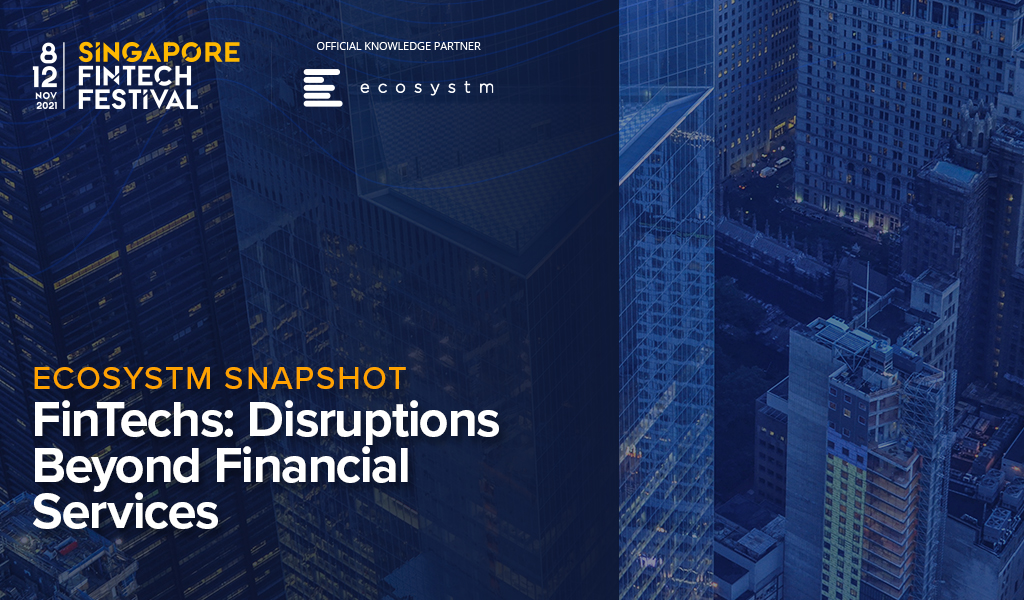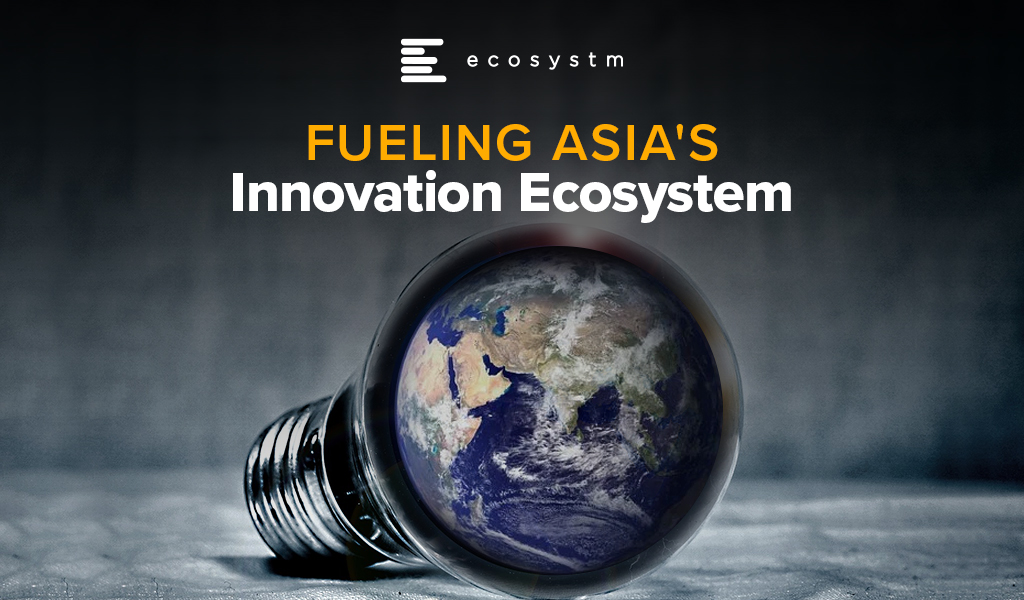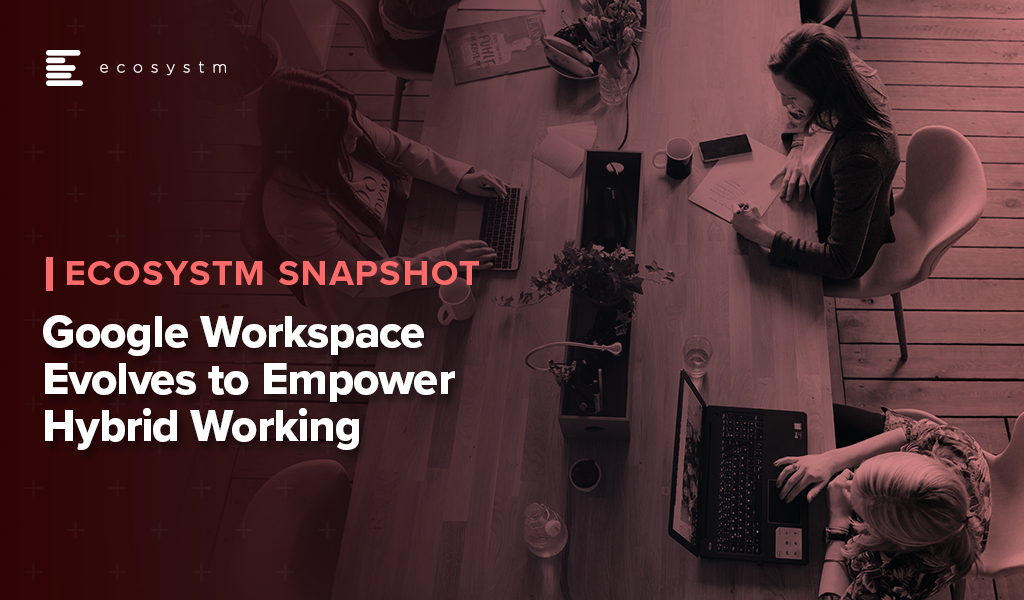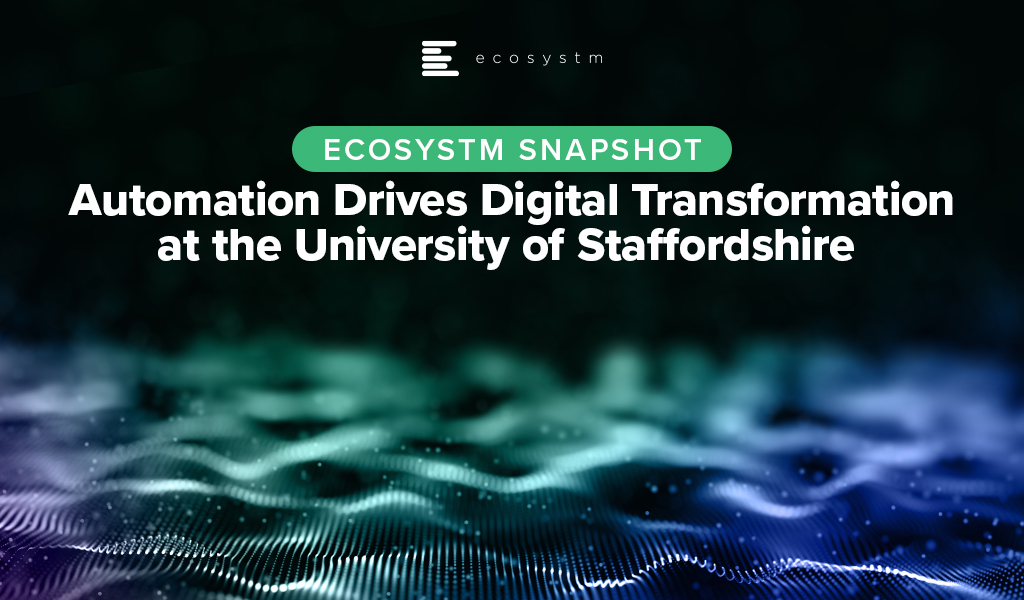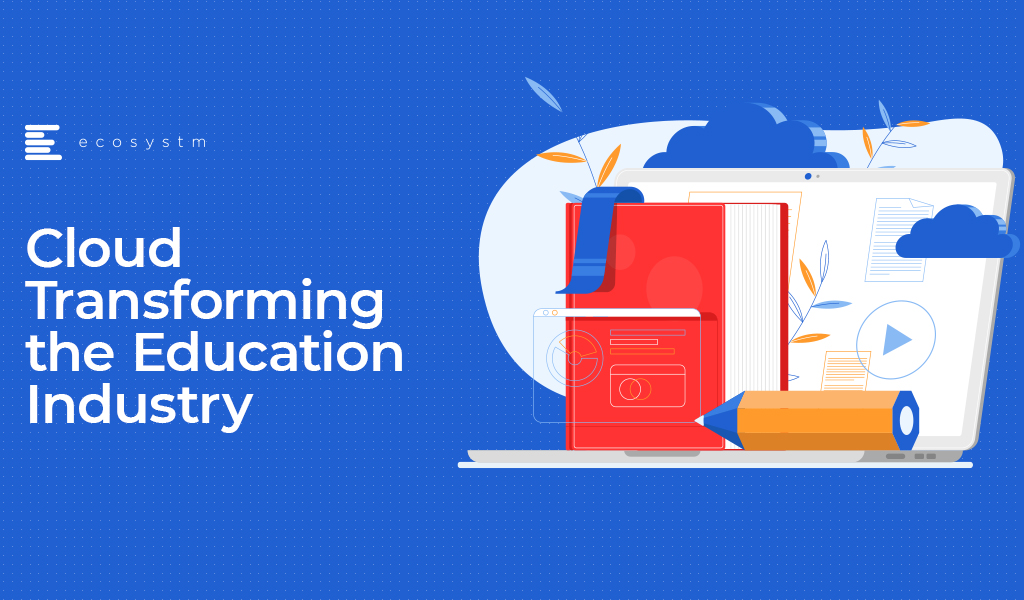Innovation is at the core of FinTechs. The Financial Services industry has been disrupted over the last few years because of the innovation and customer experience that FinTechs offer. But the FinTech world has become highly competitive, and there are many companies that do not make it, despite the innovations.
There are many factors that contribute to the success of a FinTech – and creating the right market differentiation is one of the key factors. This Ecosystm Snapshot looks at how FinTechs – such Earnest, Flock, Billd, Littlepay, Willa and AffiniPay – are disrupting industries as they build solutions targeted at those specific industries, to create the market differentiation required to succeed.

Since the start of this millennium, no region has transformed as much as Asia. There has been significant paradigm shifts in the region and the perception that innovation starts in the US or in Europe and percolates through to Asia after a time lag, has been shattered. Asia is constantly demonstrating how dynamic, and technology-focused it is. This is getting fueled by the impact of the growing middle class on consumerism and the spirit of innovation across the region. The region has also seen a surge in new and upcoming business leaders who are embracing change and looking beyond success to creating impact.
What is Driving Innovation in Asia?
The “If you ain’t got it, build it” attitude. One of the key drivers of this shift is the age of the average population in Asia. According to the UN the Asia Pacific region has nearly 60% of the world’s youth population (between the age of 17-24). With youth comes dynamism, a desire to change the world, and innovation. As this age group enters the workforce, they will transform their lives and the companies they work in. They are already showing a spirit of agility when it comes to solving challenges – they will build what they do not have.
The Need to enable Foundational Shifts. The younger generation is more aware of environmental, social and governance issues that the world continues to face. Many of the countries in the region are emerging economies, where these issues become more apparent. COVID-19 has also inculcated an empathy in people and they are thinking of future success in terms of impact. The desire to enable foundational shifts is giving direction to the transformation journey in the region. The wonderful new paradigm that is the Digital Economy allows us to cut across all segments; and technology and its advancements has immense potential to create a more sustainable and inclusive future for the world.
Realising the Power of Momentum. The pandemic has caused major disruptions in the region. But every crisis also presents an opportunity to perhaps re-imagine a brighter world through a digital lens. The other thing that the pandemic has done is made people and organisations realise that to succeed they need to be open to change – and that momentum is important. As organisations had to pivot fast, they realised what I have been saying for years – we shouldn’t “let perfect get in the way of better”. This adaptability and the readiness to fail fast and learn from the mistakes early for eventual success, is leading to faster and more agile transformation journeys.
Where are we seeing the most impact?
Industries are Transforming. There are industries such as Healthcare and Education that had to transform out of a necessity and urgency brought about by the COVID-19 pandemic. This has led to a greater impetus for change and optimism in these industries. These industries will continue to transform as governments focus significantly on creating “Social Safety Nets” and technology plays a key role in enabling critical services across Health, Education and Food Security. Then there are industries, such as the Financial Services and Retail, that had a strong customer focus and were well on their digital journeys before the pandemic. The pandemic boosted these efforts.
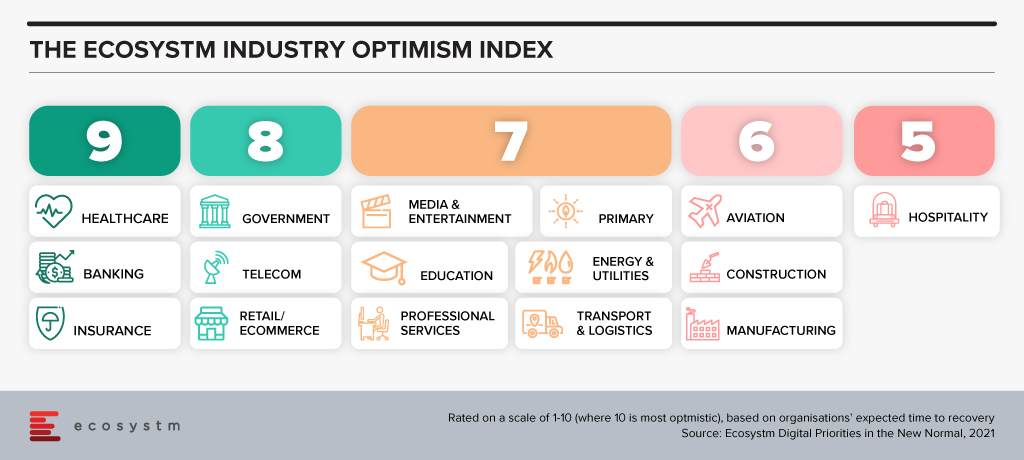
But these are not the only industries that are transforming. There are industries that have been impacted more than others. There are several instances of how organisations in these industries are demonstrating not only resilience but innovation. The Travel & Hospitality industry has had several such instances. As business models evolve the industry will see significant changes in digital channels to market, booking engines, corporate service offerings and others, as the overall Digital Strategy is overhauled.
Technologies are Evolving. Organisations depended on their tech partners to help them make the fast pivot required to survive and succeed in the last year – and tech companies have not disappointed. They have evolved their capabilities and continue to offer innovative solutions that can solve many of the ongoing business challenges that organisations face in their innovation journey. More and more technologies such as AI, machine learning, robotics, and digital twins are getting enmeshed together to offer better options for business growth, process efficiency and customer engagement. And the 5G rollouts will only accelerate that. The initial benefits being realized from early adoption of 5G has been for consumers. But there is a much bigger impact that is waiting to be realised as 5G empowers governments and businesses to make critical decisions at the edge.
Tech Start-ups are Flourishing. There are immense opportunities for technology start-ups to grow their market presence through innovative products and services. To succeed these companies need to have a strong investment roadmap; maintain a strong focus on customer engagement; and offer technology solutions that can fulfil the global needs of their customers. Technologies that promote efficiency and eliminate mundane tasks for humans are the need of the hour. However, as the reliance on technology-led transformation increases, tech vendors are becoming acutely aware that they cannot be best-in-class across the different technologies that an organisation will require to transform. Here is where having a robust partner ecosystem helps. Partnerships are bringing innovation to scale in Asia.
We can expect Asia to emerge as a powerhouse as businesses continue to innovate, embed technology in their product and service offerings – and as tech start-ups continue to support their innovation journeys.
Ecosystm CEO Amit Gupta gets face to face with Garrett Ilg, President Asia Pacific & Japan, Oracle to discuss the rise of the Asia Digital economies, the impact of the growing middle class on consumerism and the spirit of innovation across the region.

The last year has really pushed the Education sector into transforming both its teaching and learning practices. The urgency of the situation accelerated the use of networking to extend the reach and range of educational opportunities for remote learning.
Education technology has rushed to embrace opportunities to facilitate a new normal for Education. This new normal must enable and support education access, experiences, and outcomes as well as aid in developing strong relationships within Education ecosystems.
Education technology, commonly known as EdTech, focuses on leveraging emerging technologies like cloud and AI to deliver interactive and multimedia coursework over online platforms. This also requires a state-of-the-art network to support. 5G provides instantaneous access to cloud services. Use of 5G – as well as network function virtualisation (NFV), network slicing, and multi-access edge computing (MEC) – has the capability of delivering significant performance benefits across these emerging educational applications and use cases.
At present, many educational institutions are aware of the possibilities, but are not active users of 5G network infrastructure (Figure 1).
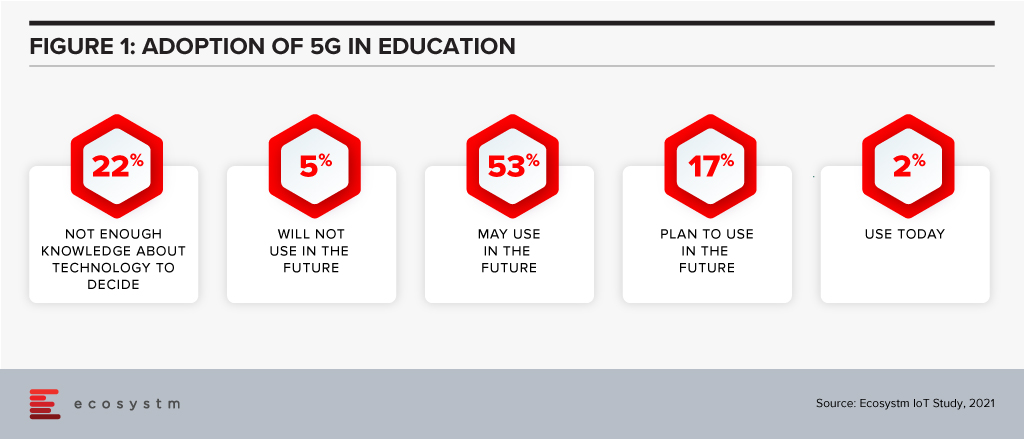
Educational institutions plan to do some near-term investments but are not clear in what areas to apply the enhanced capabilities (Figure 2).
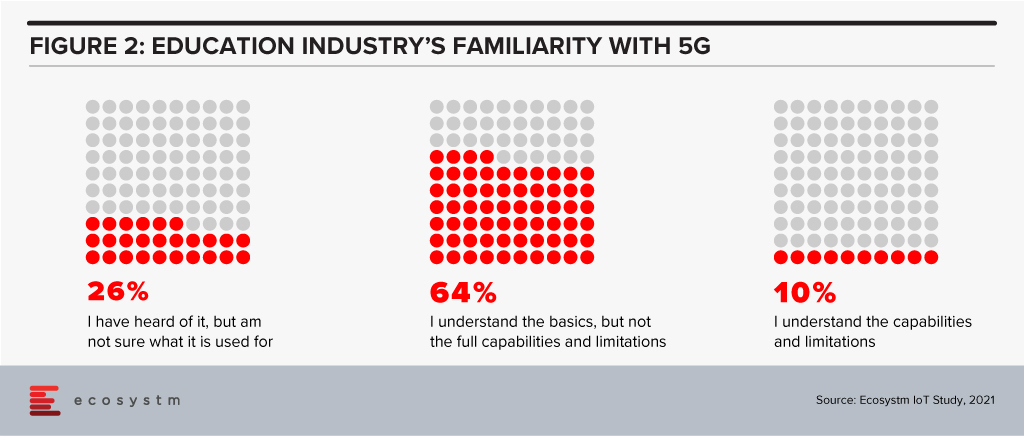
Role of the Network in Adaptive Learning
In their recent whitepaper, network provider Ciena talks about “the concept of an adaptive learning strategy – a technology-based teaching method that replaces the traditional one-size-fits-all teaching style with one that is more personalised to individual students. This approach leverages next-generation learning technologies to analyse a student’s performance and reactions to digital content in real-time, and modifies the lesson based on that data.”
To create an adaptive learning strategy that can be individualised, these learners need to be enabled by technology to be immersed in a learning experience, complete with multimedia and access to a knowledge base for information. And this is where a solid 5G network implementation can create access and bandwidth to the resources required.
Example of 5G and Immersive Learning
An example of adaptive learning where the technology not only supports but challenges the learner can be found in a BT-led new immersive classroom developed within the Muirfield Centre in Cumbernauld, North Lanarkshire, using innovative technology to transform a classroom into an engaging and digital learning environment.
Pupils at Carbrain Primary School, Cumbernauld, were the first to dive into the new experience with an underwater lesson about the ocean. The 360-degree room creates a digital projection that uses all four classroom walls and the ceiling to bring the real-world into an immersive experience for students. The concept aims to push beyond traditional methods of teaching to create an inclusive digital experience that helps explain abstract and challenging concepts through a 3D model. It will also have the potential to support students with learning difficulties in developing imagination, creative and critical thinking, and problem-solving skills. BT has deployed its 5G Rapid Site solution to support 5G innovation and digital transformation of UK’s Education sector. The solution is made possible through the EE 5G network which brings ultrafast speeds and enhanced reliability to classrooms.
Conclusion
5G is expected to provide network improvement in the areas of latency, energy efficiency, the accuracy of terminal location, reliability, and availability – therefore creating the ability to better leverage cloud capacity.
With the greater bandwidth that 5G provides, learners and instructors, can connect virtually from any location with minimal disruption with more devices than on previous networks. This allows students to enjoy a rich learning experience and not be disadvantaged by their location for remote learning, or by the uncertainty of educational access. This also provides more possibilities of exploration and discovery beyond the physical confines of the classroom and puts those resources in the hands of eager learners.
As educational institutions reopen, institutions are looking at ways to redesign the education experience. Connected devices are helping schools and universities expand the boundaries of education. Explore what the IoT-enabled future of education would look like

The ways we connect, create, collaborate in our workplaces has seen major shifts in the last year. And the tech industry has continually supported that shift as they create new capabilities and upgrade existing ones. Technology providers will continue to revamp their product offerings to support the increase in adoption of the hybrid work model work – a fusion of remote and in-office. In the Top 5 Future of Work Trends for 2021, Ecosystm had predicted, “Every major digital workspace provider (such as Microsoft, Google, Zoom, Cisco, AWS and so on) will broaden their digital workplace capabilities and integrate them more effectively, making them easier to procure and use. Instead of a “tool-centric” approach to getting work done (chat vs video vs document sharing vs online meetings vs whiteboards and so on), it will become a platform play.”
Ecosystm Principal Advisor, Ravi Bhogaraju says, “It is becoming clear that companies and individuals are grappling with three issues – the changing size and composition of the workforce; the productivity of those who are driving the businesses; and attracting, reskilling and engaging the broader workforce.” These are the challenges that tech providers will have to help organisations with.
Google Upgrades its Collaboration Platform
The Google Workspace was launched in October last year, and last week saw the tech giant announce a series of upgrades and innovations to better support the flexibility needs of frontline and remote workers.
Workspace is Google’s office productivity suite comprising video conferencing, cloud storage, collaboration tools, security and management controls built into a cohesive environment. The new features announced by Google Workspaces include Focus Time to avoid distractions by limiting notifications, recurring out-of-office and location indicators to make colleagues aware if the person is working from home or office, support for Google voice assistant in workplaces, second-screen experiences to support multiple devices, and features for frontline workers designed to help mobile employees collaborate and communicate better with the rest of the organisation. Google is also working on a trimmed down version of Google Workspace – Google Workspace Essentials – which will provide support for Chat, Jamboard, and Calendar. Workspace is estimated to have 2.6 billion monthly active users.
Bhogaraju says, “One of the issues that is fast emerging as significant is not just the employee experience or customer experience but the complexity of the digital workplace as platforms introduce newer and advanced features. In the end, there has to be simplicity, clarity, and a clear focus on the goals – not just an overload of features that makes life more complex for the employee. It would be critical to enable these features thoughtfully and reskill staff adequately so that the adoption and impact to business process is felt in their day-to-day activities.”
Workspace Transformation across Industries
With many of Google’s employees and developers working remotely, the company has first-hand experience of the challenges of remote working and is leveraging the experience. Google Workspace is also working on custom solutions for various industries. In Retail for example, Woolworths, rolled out Google Workspace and Chrome for geographically dispersed teams to collaborate in real-time and adopt custom-made applications linked to global servers to allow managers to log and address tickets from the shop floor itself. Similarly in Aviation, All Nippon Airways uses Google Workspace to allow pilots, cabin attendants, HR and finance staff to communicate and collaborate in real-time across the globe, using Google Meet, Google Docs, Google Sheets and Google Slides from their PCs, smartphones or tablets. Google retains its focus on the Education industry – Google Workspace Education Fundamentals is free for all qualifying institutions. Solutions such as Google’s Classroom, Teach from Anywhere hub, roster sync, mobile grading and EdTech tools aim to enable better learning and teaching experience for students and educators.
Tech Companies Revamping their Collaboration Offerings
With more companies rethinking their work policies, leaders in the collaboration space are also stepping up their game to evolve their offerings for the hybrid norm. Microsoft’s Viva unifies the experience across Teams and Microsoft 365 for employee communications, wellbeing, learning and knowledge discovery. Similarly, Zoom too has upgraded and integrated various utility, sharing, and management features to support a hybrid workforce. Tech companies are being forced to invest in creating next-generation tools to stay relevant, as Future of Work models continue to shift and evolve.
As tech companies evolve their capabilities, Bhogaraju warns organisations on how they should leverage them. “While technology companies continue to deliver feature rich suites – in reality the uptake and embedding of these programs into the day-to-day business processes is still in its early stages. Business, HR and IT teams continue to struggle. They tend to operate within independent thought silos and there is limited consensus on which feature is really needed and how it can add to the productivity and efficiency. Without this crucial context and an effective change management program – they remain rich features and not impactful ones.”
The hybrid workplace model is gaining popularity in 2021. Check out Ecosytsm’s top 5 Future of Work Trends For 2021. Signup for Free to download the report.

The Education sector is currently facing immense challenges with enabling a remote learning environment and ensuring the safety of staff, employees, and students. This is on top of the usual challenges of resource optimisation, student retention, student recruitment, and so on. Moreover, today’s students are millennials and post-millennials, who are digital natives – pushing educational institutions to adopt technology to attract the right cohort and provide an education that equips the students for the workplace of the future. The industry is being driven to transform, to keep up with student expectations on delivery, access to the resource, and how they choose to communicate with their educators and peers.
Ecosystm Principal Advisor, Dr Alea Fairchild says, “Education administration budgets are not increasing, but the pressure for quick response and more personalised interaction for students, means that administrators need to focus on interaction as the core competency. This requires institutions to automate as much of the volume back-office activity as feasible. The challenge is that individualised course structures mean more complex billing configurations.”
Dr Fairchild, who is active in international education in Belgium, says, “Individual study paths, including Erasmus exchanges, create a need for an audit trail on transfers, exemptions and completions.”
Ecosystm research finds that educational institutions are focused on adopting emerging technologies mainly to improve student services (Figure 1). The processes are being automated to reduce risks, errors and turnaround times for results and application processing, while also removing repetitive tasks so administration can focus on more value-add student-facing activities.
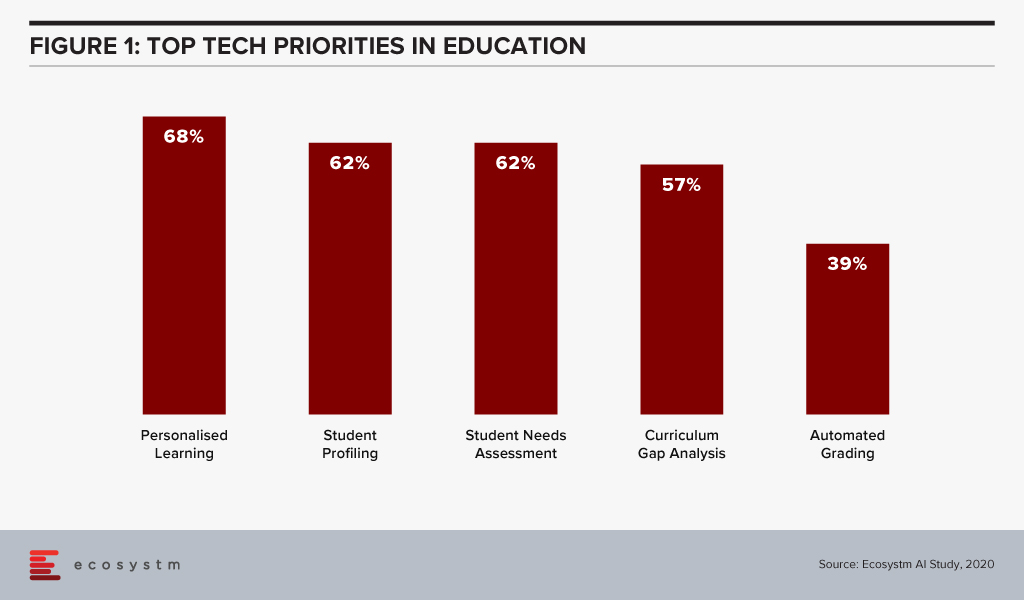
University of Staffordshire Embraces Digital Transformation
The University of Staffordshire is a “connected university” with an emphasis on industry connections and graduate employability. At the heart of Stoke-on-Trent and a regional hub for healthcare education, the university has six schools as well as a well-known degree in computer games design.
The UK-based University has over the years built a reputation for being keen on embracing digital as a way of better management, offering better student services, and serving the larger community. In 2018, Staffordshire University announced plans to build a multi-million-pound apprenticeship hub at its Stoke-on-Trent campus supported by tech giants including Microsoft to equip students with digital skills and to deliver more than 6,500 new apprenticeships over the next decade.
Last year, the University implemented a digital assistant, called Beacon, hosted on Microsoft Azure Cloud that provides support to their students on their learning and on-campus activities, including monitoring their emotional well-being and providing recommendations on groups and societies that they might be interested in. Beacon aims to ease the life of a university student, acting as a digital coach, and to minimise drop-outs due to stress and uncertainty.
Like its peer organisations, in the wake of the pandemic, the university was able to implement a blended learning program – offering courses through digital and remote learning systems from this semester for the entire 2020-21 session.
Focusing on Transformation through Automation
The University of Staffordshire, recently implemented robotic process automation (RPA) as part of its digital transformation plan. Talking about the role of RPA in Education, Dr Fairchild says, “This is a recent trend in higher education, with other new initiatives seen at the University of Auckland and University of Melbourne. RPA as a tool is used in Education to achieve the service levels required to meet both students’ and potential students’ expectations. This includes downloading student applications, processing language waiver requests, and entering academic results. These are all rule-based, high volume applications where automation increases speed and reduces errors.”
The University is using Blue Prism Cloud to access the RPA software and has plans for a automation-led digital transformation roadmap. Dr Fairchild says, “Blue Prism is based on Java and uses a Top-Down approach. It offers a visual designer with no recorders, scripts, or any intervention. Blue Prism is based on process diagrams that utilise core programming concepts and create the operational process flows to analyse, modify and scale business capability.”
The Staffordshire Digital team initially implemented RPA in the Finance department, as it involves a lot of administrative and back-office operations such as management of finance, records, tuition fees details and more. The University’s emphasis is to free up personnel and make them focus on more productive areas. This is beneficial for both the administrative staff’s feeling of personal contribution as well as student service satisfaction levels. “Using RPA gives the opportunity to universities to revisit, redesign, and improve their existing processes in line with expectations from digital native students. For prospective students, the next wave of RPA integration is intelligent machine learning algorithms to help route emails and integrate chatbots to address questions on course selection,” says Dr Fairchild.

The COVID-19 pandemic is debilitating industries, and economies around the world are facing the prospect of a recession. Malaysia, like many other countries, is focussing on front-line medical efforts and security services to save lives and contain the deadly, rapidly spreading virus. Essential services such as food, water and energy supply, Telecommunications, Banking, eCommerce and logistics are working overtime in this new order to support basic functions. The measures put in place to mitigate the spread of the virus are obviously inhibiting other economic activities.
Until enough people develop an immunity to the virus – either through a vaccine or naturally – it is hard to envisage lifting these movement control measures and return to a pre COVID-19 state. Malaysia has a total of 4,987 positive cases, the highest in Southeast Asia and a death toll of 82 as of today. The number of the population tested remains low at 81,730 as reported by the Ministry of Health, mainly due to limited testing resources.
The biggest challenge is that this epidemic is unprecedented, and it is unclear when we can put this situation behind us. The Malaysian Industry of Economic Research (MIER) has predicted about 2.4 million job losses as well as the GDP to reduce by 2.9 percent in 2020. Public debt rise coupled by reduced income due to lower crude oil, natural gas and palm oil prices and demand, will hit the Government coffers hard. Interest rates are expected to be low through the current lockdown stage right up to the recovery stage to help support the economic recovery.
Government Initiatives for the Economy
Like many countries, Malaysia has announced economic stimulus packages to ensure help for the poor and needy, that workers do not lose their jobs and that companies avoid bankruptcy – albeit with an inevitably reduced output – to keep the economy functioning. The stimulus offered is short-term covering a few months, and more assistance will be required should the epidemic linger and for the recovery period.
The Government announced a stimulus package on the 27th February worth RM20 billion (US$4.5 billion) and another one on the 27th March worth RM230 billion (US$52.6 billion). The packages comprise of direct fiscal injection of RM25 billion (US$5.7 billion) as well as loan deferments, one-off cash assistance, credit facilities and rebates. The focus of the stimulus packages is to assist people in the lower-income (B40) and mid-income (M40) groups, aid for employees in the private sector and for traders during the movement control order (MCO) which is to run until 14th April 2020.
An additional COVID-19 stimulus package worth RM10 billion (US$2.2 billion) was announced on the 6th April to address the challenges of the small and medium enterprises (SMEs) that employ two-thirds of the workforce and contribute to 40 percent of the GDP. The wage subsidy is to benefit 4.8 million workers earning less than RM4,000 (US$915) per month. In addition, SMEs will have access to interest free loans of RM200 million (US$45.7 million) from the National Entrepreneur Group Economic Fund and a further RM500 million (US$114.4 million) via Bank Simpanan Nasional. The Government allowed 750,000 SMEs to postpone income tax payment for three months from 1st April – companies in the tourism sector are allowed to postpone income tax for six months.
Impact on Industries
Banking & Financial Services. Banking institutions will support the Government’s stimulus initiatives by providing a six months’ loan repayment moratorium, corporate loan restructuring and conversion of credit card balance to long term loans. Banking and financial institutions are focussing on business continuity planning to ensure minimal disruption to their business and customer support. Many key business processes are now being put to test in-home working with scaled-down office operations. Digital Transformation (DX) has been accelerated as a result.
Contactless payments have seen a boost and many financial institutions have increased payment limits for such payments. Early last month the World Health Organisation (WHO) and the Bank of England had issued advisories against the use of banknotes, as it could increase the chances of the virus spread, instead recommending the use of contactless payment where possible. This might give a boost to the use of Cryptocurrency and cross-border payment services in Malaysia. In 2019, cryptocurrency start-ups received an estimated 12 percent of Fintech funding – but, only three cryptocurrency exchanges were given conditional approval by the Securities Commission. The current situation may well see that changing.
Insurance. The Prime Minister announced that the Insurance industry is to create a fund of RM8 million (US$1.8 million) to cover the cost of RM300 (US$68.6) per policyholder to undergo COVID-19 tests. In addition to this, insurance companies are to offer a 3-month suspension on premiums for policyholders whose income is affected by the pandemic.
Agriculture. Even prior to COVID-19, there has been a brewing narrative against globalisation, favouring a nationalistic emphasis as reflected globally by Brexit and the China-US trade wars tension. Food security is key, and COVID-19 has further highlighted its importance with priorities shifting to local requirements over exports. The Government intends to distribute a food security fund of RM1 billion (US$228.8 million) to increase the local production of farms, fisheries and livestock. According to the Department of Statistics, Malaysia’s food and beverage imports amounted to RM54 billion (US$12.3 billion) in 2018 while food exports stood at RM35 billion (US$8.0 billion) resulting in a trade deficit of RM18.8 billion (US$4.3 billion). As countries focus on internal supplies instead of exports in the current scenario, Malaysia needs to address this risk by producing more locally.
Impact on Industry Transformation
Amidst the gloomy outlook, there are plenty of opportunities, especially to the country’s Digital Economy. Malaysia has been committed to the Digital Economy vision with the Malaysia Digital Economy Corporation (MDEC) estimating that the country’s Digital Economy is worth US$3 trillion. The COVID-19 crisis may well be the key driver in achieving that vision. DX efforts are being accelerated with businesses adopting more cloud and mobility solutions. More workloads have to be digitalised and there is greater adoption of Cloud for storage and services. AWS, Microsoft Azure and Google Cloud will be beneficiaries in this area.
I have already spoken about the Financial Services industry – other industries are also getting transformed out of a necessity to survive this crisis. The Education sector has seen an increase in access to educational content and traffic to education portals and blogs. Some schools have implemented online lessons and group chats between teachers, students and parents to ensure education continues through this pandemic. Many universities have used their e-learning platforms to move lectures online.
The Telecommunications industry is being appreciated more than ever and it is the backbone to normal life, in both a social and business sense. The Government’s stimulus package includes offers of free internet to all customers until the MCO is over at RM600 million (US$137.3 million) and an investment of about RM400 million (US$91.5 million) to improve coverage and quality of service. Leading operators Maxis, Digi, Celcom and U Mobile have offered 1GB free data during the MCO period. The Axiata Group recently announced a cash fund of RM150 million (US$34.3 million) to assist micro-SMEs within the ecosystem providing eCommerce, digital payments and related services.
Video conferencing traffic is on the rise as it is the next best thing to face-to-face meetings. Microsoft Teams and Zoom have been the biggest winners so far. The home working trend should continue in the recovery stage and beyond, due to improvements in the telecommunications infrastructure and the impending rollout of 5G.
The eCommerce sector should see a major improvement in Malaysia with physical channels to the market being suspended. Malaysians have not embraced eCommerce like mature economies have, and it has significant room for improvement. Development of the SME sector and eCommerce are twin focus areas for the Digital Economy vision. Statista reports that the average Malaysian eCommerce shopper spent just US$159 on online consumer goods purchases in 2018, considerably lower than the global average of US$634. There is huge opportunity to provide for necessities such as online grocery, food and delivery of goods. As a consequence, the Transport & Logistics sector will have to adapt their business operations in order to ride this wave successfully.
Video streaming and gaming has also seen an increase in consumption in these times as they provide for entertainment for millions stuck at home. Netflix, YouTube, Microsoft Xbox and PlayStation are among the winners in this sector. YouTube provides for a primary news source and commentary on the epidemic for many. There provides a tremendous opportunity for both telecom operators and content providers to increase their number of services in this area.
Malaysia, like all other countries, will have to ride out this wave. It has made a positive step in the direction with the stimulus packages, especially for the SME sector. How well the country rides this wave out will depend on how targeted the future stimulus packages are and how fast industries can transform to handle the new world order that will emerge after the COVID-19 crisis.
Over the last few years, there has been a noticeable increase in the number of educational institutions adopting technology to deliver solutions such as learning management, collaboration and support activities. The ubiquity of cloud solutions allows institutions to focus on enhancing the educational experience for students, teachers and administration through emerging teaching methods such as online platforms, interactive systems, and remote management of mission-critical projects and research.
Drivers of Transformation in Education
Education systems, depending on the country, face several problems ranging from achieving universal education goals, limited access to resources, student retention, student recruitment, to conducting cutting-edge research. Moreover, today’s students are millennials and post-millennials, who are digital natives – pushing educational institutions to adopt technology to attract the right cohort and provide an education that equips the students for the workplace of the future. The industry is being driven to transform to keep up with student expectations on delivery, access to the resource, and how they choose to communicate with their educators and peers. Cloud-based offerings are helping educational institutions to overcome these challenges. The top drivers of Education are:
- Personalised Learning. Modern pedagogy encourages personalised learning, where students can choose their own learning path. With the growth of virtual learning environments and eLearning technologies, institutions are able to change the ways they teach, tailoring the curriculum to individual needs, monitoring an individual’s learning journey and providing just-in-time feedback.
- Collaborative Education. Collaborative education principles are based on the premise that many students learn better by communicating with their peer network and not in silos. Also, increasingly, especially at the primary and secondary levels, parents are regarded as a significant stakeholder in a child’s education.
- Efficient Delivery. Most educational institutions are focused on efficient delivery, not only to be more financially sustaining but also so that students, teachers and administration have the ability to access information, including content and learning management systems, anytime and anywhere. The focus is on creating more a flexible work environment and increasing practicality and ease of use for students and educators.
The global Ecosystm AI study reveals the top priorities for educational institutions focused on adopting emerging technologies.

Cloud as an Enabler of Transformation
Cloud gives access to an immense knowledge base that students, educators, and institutions as a whole can leverage. The reach and availability of connectivity has increased the number of users of cloud-based education solutions for remote learning, which helps in the goal of personalised learning. Cloud solutions can also fulfil the demand for collaborative education with reliable and scalable infrastructure. It enables a more collaborative teaching and learning approach, with easy maintenance and management of monitoring and control solutions. Moreover, it promotes efficient delivery as educational institutions look to migrate legacy systems onto the cloud, and increasingly procure SaaS solutions. Cloud not only reduces the burden on an institution’s CapEx but is increasingly being seen as an essential enabler of digital transformation (DX).
In fact, the key benefits that educational institutions are realising from cloud adoption, according to the global Ecosystm Cloud study, are:
- Increased work process efficiency. As the industry becomes more complicated with the advances in pedagogy and technology, cloud is helping institutions to streamline workflows and enabling the participation of multiple stakeholders, some on campus and some remote. One must not forget that education requires an immense amount of administrative work, by both teachers and allied workforce.
- Improved service levels and business agility. The scalability that Cloud provides, especially during high-volume periods such as admissions and examinations, gives educational institutions the ability to be agile. Also, back-up and disaster recovery are key in education, and many institutions start their Cloud journey with storage and back up.
- Simplified sharing of systems/information across departments. Information sharing across different departments becomes easier with the rising penetration of mobile devices such as phones, tablets, and laptops in the classrooms for both students and teachers. Cloud technology ensures that the data shared between devices occurs safely and efficiently.
Examples of Transformation in Education
Virtual Classrooms and Schools
Unlike traditional methods of teaching, virtual classrooms are enabling students to learn and access content without their presence in schools or universities and from anywhere across the globe. The benefit of virtual schools and classrooms is that they do not require any heavy infrastructure or technical equipment to run. In a virtual world, teachers and students can connect with each other in a fast, flexible, and cost-effective way. It enables teachers to host live chats, share lectures and videos, create interactive learning activities and receive instant student feedback.
For example, Florida Virtual School is a full-time online school providing virtual K-12 education to students all over the world. It is a recognised eLearning school and provides custom solutions to meet students’ requirements. This model is being replicated globally especially in remote areas where an actual school premise may not be feasible or is too expensive.
Research & Experimentation
The remote handling of projects and experiments is enabling education institutions to overcome the challenge of carrying them out in a controlled and safe environment. ChemCollective, a project of the National Science Digital Library in the US, enables students to interact with a flexible learning environment in which students can access online chemistry labs to apply formulas, perform experiments and learn in realistic and engaging ways, like working scientists.
Open Education Resources
Cloud is enabling the development of open source content for schools and colleges. The challenge with the existing books and lectures is that they get dated. Cloud is enabling a wealth of content through open repositories and legal protocols to allow a community to collaborate and update the information. Open educational resources (OERs) are developed and can be modified by the creators and administrators. The community can contribute to maps, slides, worksheets, podcasts, syllabi or even textbooks. The copyright is associated via legal tools such as Creative Commons licenses, so others can freely access, reuse, translate, and modify them.
As textbooks and course material can now be updated in real-time and offered through a cloud-based subscription model, this now opens up new streams of revenue for publishers. However, this then raises the conversation that textbook prices are increasing while students have no option to purchase second-hand books or sell books once they are done with them.
MOOCs
Massive Open Online Courses (MOOCs) platforms both provide content to students in areas of personal interest and additional sources of revenue to renowned global institutions. A quick look at Coursera’s website shows online courses from reputed institutions such as MIT and Johns Hopkins University. There are still providers such as the Khan Academy that do not actively monetise the material they provide, but increasingly institutions look at MOOC to generate more revenues, by offering remote learning options to individuals, as well as by collaborating with local universities to make their courses available to overseas students – a previously untapped market.
Cloud computing is transforming the classroom and learning experiences the way educators, curriculum leads, and specialists recommend. The technology has a huge role to play in enabling transformation in Education – for national education systems, for educational institutions, and ultimately for the students.
How else do you think Cloud can transform the education industry? Let us know in your comments below.


